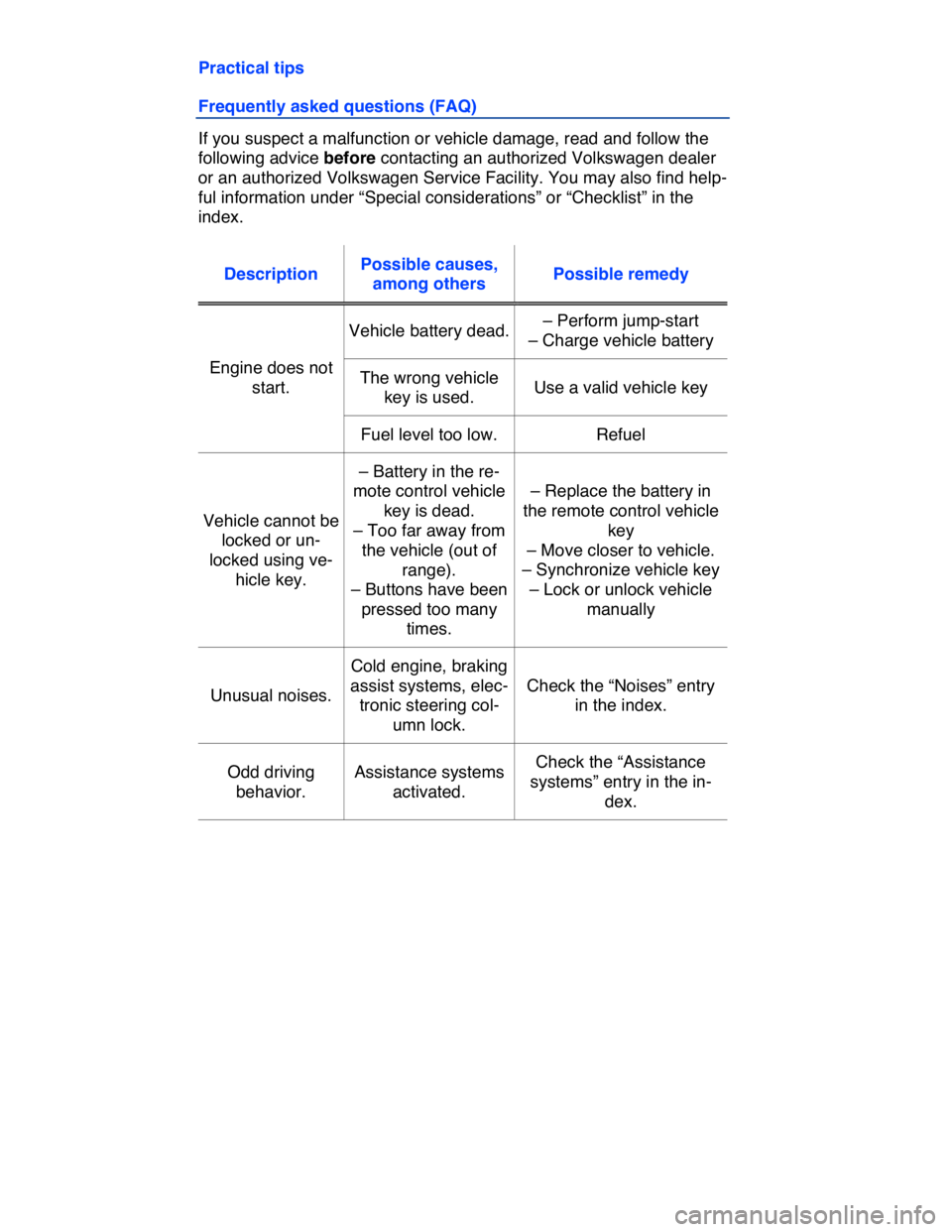Page 376 of 578

Orientation lines overview
Meaning of the orientation lines projected on the screen ⇒ fig. 154. All
distances of the orientation lines refer to a vehicle on a level surface.
(1) Red: Safety distance. Area up to about 16 inches (40 cm) behind
the vehicle on the road.
(2) Green: Vehicle extension (somewhat wider) toward the rear. The
green area ends about 6 feet (2 meters) behind the vehicle on
the road.
(3) Yellow: The extension of the vehicle to the rear showing the ve-
hicle path as determined by the position of the steering wheel.
The yellow area ends about 10 feet (3 meters) behind the vehicle
on the road.
Parking
� Position the vehicle in front of a parking space and shift into Re-
verse.
� Slowly back up and steer so that the yellow orientation lines lead
into the parking space (3).
� Align the vehicle so that the green and yellow orientation lines are
parallel with the parking space.
Parallel parking (Mode 2)
Fig. 155 On screen: Orientation lines and area of the parking space
behind the vehicle.
�
Page 377 of 578

When a turn signal is set, unnecessary lines and areas are hidden.
Orientation lines overview
Meaning of the orientation lines and areas projected on screen
⇒ fig. 155. All distances of the orientation lines refer to a vehicle on a
level surface.
(1) Red: Safety distance. Area up to about 16 inches (40 cm) behind
the vehicle on the road.
(2) Vehicle's width limits.
(3) Point to change steering angle.
When the yellow line touches the curb or any other parking
space boundary, the steering wheel must be turned in the oppo-
site direction (close-up view).
(4) The area parallel to the vehicle that is needed for parking. The
area shown must fit completely into the parking space.
(5) Parked vehicle at the curb.
Parking
� Position the vehicle about 3 feet (1 meter) away from and parallel
to the parking space and shift into Reverse.
� On the screen of the navigation system, activate Mode 2 for paral-
lel parking.
� Back up slowly and steer the vehicle so that the yellow surface on
the screen is flush with the side boundary of the parking space (such
as the curb) and stops short of any obstacle (5), such as another ve-
hicle.
� Turn the steering wheel as far as it will go into the direction of the
parking space and slowly back up.
� Once the yellow line (3) touches the side of the parking space, for
example, a marking or the curb (close-up view), turn the steering
wheel as far as it will go in the opposite direction.
� Continue backing up until the vehicles is positioned in the parking
space parallel to the road. If necessary, correct the parking position.
It may take up to 5 seconds for the area detected by the sensors
to be displayed on the factory-installed radio or navigation system
screen.
Page 474 of 578
WARNING
Using solvents or other improper cleaning products on surfac-
es where airbags are located can change the way airbags de-
ploy in a crash.
� Products containing solvents will change the properties of
the plastics and may cause plastic parts to break and fly
around when the airbag deploys in a crash, causing injury.
� Never use solvents or cleaners on the steering wheel horn
pad or on the instrument panel because they can damage the
airbag cover or change the stiffness or strength of the material
so that the airbag cannot deploy and protect properly.
� When cleaning the horn pad and instrument panel, use only a
soft, dry cloth or a cloth moistened with plain water.
Cleaning the safety belts
�
Page 484 of 578

WARNING
Items stored between the safety belt buckle and the center con-
sole can cause safety belt buckle to send the wrong infor-
mation to the airbag control unit and prevent the Advanced Air-
bag System from working properly.
� Always make sure that nothing can interfere with the safety
belt buckles and that they are not obstructed.
WARNING
Improper care and servicing, and improper modification and
repair work, can increase the risk of personal injury and death
by preventing an airbag from deploying when needed or de-
ploying an airbag unexpectedly:
� Never repair, adjust, or change any parts of the airbag sys-
tem.
� All work on the airbag system, steering wheel, instrument
panel, front seats or electrical system (including the installation
of audio equipment, mobile telephones and CB radios, etc.)
should be performed by authorized Volkswagen dealers or au-
thorized Volkswagen Service Facilities. They have the neces-
sary manuals, training, and special equipment.
� The airbag system can be activated only once. After an air-
bag has inflated, it must be replaced.
� Use only original equipment airbags approved by
Volkswagen. Have them installed by a trained technician who
has the necessary tools and diagnostic equipment to properly
replace any airbag in your vehicle and assure system effective-
ness in a crash.
� Never permit salvaged or recycled airbags to be installed in
your vehicle.
Undeployed airbag modules and safety belt pretensioners are
classified as Perchlorate Material. Special handling may apply – see
http://www.dtsc.ca.gov/hazardouswaste/perchlorate. Obey all appli-
cable legal requirements regarding handling and disposal of the vehi-
cle or parts of its restraint system, including airbag modules and safe-
ty belts with pretensioners. Authorized Volkswagen dealers and au-
Page 488 of 578

charged. You might also experience more dropped calls and an over-
all impaired quality of the connection.
Therefore we strongly recommend that you use your mobile tele-
phone in your vehicle only when it is properly attached to an appro-
priate cradle mounted on a base plate on the instrument panel.
Because of the large number and variety of mobile telephones on the
market and the frequency with which new models are introduced,
Volkswagen does not offer cradles for mobile telephones. Please
check with the manufacturer of the mobile telephone that you plan to
use.
Bluetooth® is a registered trademark of Bluetooth® SIG, Inc.
WARNING
A mobile phone on the seat, instrument panel or in other places
can be thrown around the inside of the vehicle during a sudden
braking maneuver, a crash or other accident and injure vehicle
occupants.
� Never place or attach accessories or other objects (such as
cup holders, telephone brackets, note pads, navigation sys-
tems, large, heavy or bulky objects) on the doors, on the wind-
shield, over or near the area marked “AIRBAG” on the steering
wheel, instrument panel, backrests or between these areas and
the occupant. Such objects could cause serious injury in a col-
lision, especially if an airbag inflates.
Page 498 of 578

Practical tips
Frequently asked questions (FAQ)
If you suspect a malfunction or vehicle damage, read and follow the
following advice before contacting an authorized Volkswagen dealer
or an authorized Volkswagen Service Facility. You may also find help-
ful information under “Special considerations” or “Checklist” in the
index.
Description Possible causes,
among others Possible remedy
Engine does not
start.
Vehicle battery dead. – Perform jump-start
– Charge vehicle battery
The wrong vehicle
key is used. Use a valid vehicle key
Fuel level too low. Refuel
Vehicle cannot be
locked or un-
locked using ve-
hicle key.
– Battery in the re-
mote control vehicle
key is dead.
– Too far away from
the vehicle (out of
range).
– Buttons have been
pressed too many
times.
– Replace the battery in
the remote control vehicle
key
– Move closer to vehicle.
– Synchronize vehicle key
– Lock or unlock vehicle
manually
Unusual noises.
Cold engine, braking
assist systems, elec-
tronic steering col-
umn lock.
Check the “Noises” entry
in the index.
Odd driving
behavior.
Assistance systems
activated.
Check the “Assistance
systems” entry in the in-
dex.
Page 529 of 578

2. Switch off the engine. Automatic transmission: shift the transmis-
sion into Park (P)) ⇒ Automatic transmission: Selector lever. Man-
ual transmission only: shift into a gear ⇒ Manual transmission:
Gearshift lever. Then set the electronic parking brake ⇒ Braking
and parking to help prevent the vehicle from moving.
3. If towing a trailer: Unhitch the trailer from the vehicle and park the
trailer properly.
4. Straighten the steering wheel so that the front wheels point straight
forward.
5. Block the diagonally opposite wheel with chocks or other suitable
things.
6. Loosen the wheel bolts of the wheel to be changed ⇒ Wheel bolts.
7. Find the jack lift point ⇒ fig. 191 on the vehicle frame that is closest
to the wheel to be changed.
8. Crank up the jack so that it still just fits underneath the lift point.
9. Position the jack so that its base is directly underneath the lift point
⇒ fig. 192, making sure that the entire base of the jack rests se-
curely on the ground.
10. Align the jack and wind up the jack claw at the same time, until
the claw cradles the vertical rib underneath the vehicle ⇒ fig. 192.
11. Continue cranking up the jack until the wheel is just a little off
the ground.
Page 532 of 578

The vehicle may only be lifted by a jack positioned at one of the four
jack lift points ⇒ .
Checklist
For your own safety and that of your passengers, carry out the follow-
ing steps in the order listed ⇒ .
1. Find a level spot on firm ground for lifting the vehicle.
2. Switch off the engine. Automatic transmission: shift the transmis-
sion into Park (P)) ⇒ Automatic transmission: Selector lever. Man-
ual transmission: shift into a gear ⇒ Manual transmission: Gear-
shift lever. Then set the electronic parking brake ⇒ Braking and
parking to help prevent the vehicle from moving.
3. If towing a trailer: Unhitch the trailer from the vehicle and park the
trailer properly.
4. Straighten the steering wheel so that the front wheels point straight
forward.
5. Block the diagonally opposite wheel with chocks or other suitable
things.
6. Loosen the wheel bolts of the wheel to be changed ⇒ Wheel bolts.
7. Find the jack lift point on the vehicle frame that is closest to the
wheel to be changed.
8. Remove the cover panel in the side sill. To do so, pull forcefully but
carefully in the direction of the arrow ⇒ fig. 193. Secure the cover
panel with the retaining strap.
9. Crank up the vehicle jack so that it still just fits underneath the lift
point.
10. Position the jack so that its base is directly underneath the lift
point ⇒ fig. 194, making sure that the entire base of the jack rests
securely on the ground.
11. Align the jack and wind up the jack claw at the same time, until
the claw cradles the vertical rib underneath the vehicle ⇒ fig. 194.
12. Continue raising the vehicle jack until the wheel is lifted off the
ground.